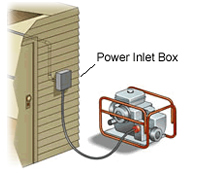Portable Generator Connections
Generator Wiring

The art of making electricity via your own personally owned generator is nothing new. However, in recent years it has become quite a bit more common. More and more people are purchasing and operating a generator during power outages, but this is not always done in the most safe and convenient way.
Many times people will run extensions cords throughout their house to each individual device that they want energized, this in itself poses a danger. Extension cords are one of the leading causes of electrical fires in residences. Closing an extension cord in a doorway or window can easily lead to worn away insulation which can lead to either electrical shock or arcing. They are also easy to trip over, especially when the lights are out.
The new craze in portable generator hook-ups is to connect it directly to the house’s electrical system. This can be a much safer way to use a generator, if it is installed correctly. The term “suicide cord” has become more widely known than ever, and it’s name is very descriptive. A suicide cord is a cord made up with two male plugs, one to plug into the generator and the other to plug into an electrical outlet, usually the electric dryer or the stove outlet. The problem with this is type of connection is when the generator is turned on and the cord is plugged into it, the other end of the cord has exposed male prongs that are energized, and ready to kill whoever accidentally touches them. If you think about your normal electrical system, you will realize that the energized parts are always the female side, this way you have no exposed energized parts to touch. A suicide cord goes against this safety standard.
The second danger in using a suicide cord is that you are back-feeding your electrical system without using any type of transfer or lockout system. What this means is that you may be pumping electricity back out into the grid- you may be sending power out onto the downed power lines that the lineman are working on and expecting to be dead. Lineman have died because of this, and the people who have illegally connected the generator have been prosecuted for manslaughter.
Some people say that they can just be sure to not touch the energized end of the suicide cord and make sure to turn their main breaker off so that they don’t back feed the grid. But is it worth the risk? Can you guarantee that you will remember the exact order of operations during a disaster? Now the real question, what if you are not home and your child connects the generator? Every teenage boy wants to be able to impress his parents and save the day when a disaster occurs. Or what if you want to explain how to get the generator running over the phone to your spouse and they make a mistake? There is no real good outcome to using the suicide cord method other than a few saved dollars, but what is the real cost of the risk?
The good news is that there are easy ways around this. Today we have legal, code complaint ways to connect a generator into your house’s electrical system. Transfer switches and interlocks will do exactly what you want while giving you a solid layer of protection from danger and error. They are a safeguard for you, your family, your house, and the men and women working on the lines to get your power back on. A properly installed interlock or generator transfer switch will positively lock out the generator connection from the grid, making sure that both cannot be on at the same time. The system will also have the proper generator inlet to connect your generator to so that there are never exposed energized parts to touch or short out.
Installing portable generator wiring with an interlock or transfer switch is one of the greatest values you can add to your home. The initial cost of the installation is always worth it when the first power outage occurs and you are sitting in a warm, safe home going about your normal activities without worry.
When you say to yourself “I want the best electrician near me”, it’s time to call Ampacity.
